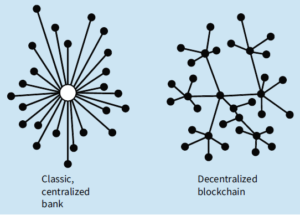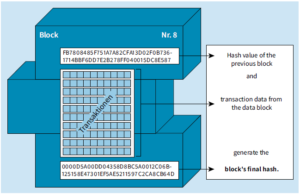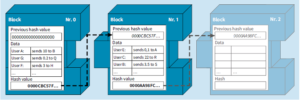This blog post is an article from a series of articles on the book published in December 2019 “Blockchain with SAP” (Rheinwerk publishing, Bonn, ISBN 978-3-8362-6914-8). The article describes the world of distributed ledger technologies in connection with blockchain-as-a-service offerings of the SAP Cloud platform. Familiarize yourself with the functionality of blockchain and its opportunities for your company, and learn from our experts.
Blockchains belong to a group of what is known as Distributed ledger technologies (DLT). These are shared account books in networks without a central authority, which were developed as an answer to the great banking crisis of 2008. Logically, the first application of a blockchain was the new cryptocurrency Bitcoin, which is self-regulating and makes intermediaries superfluous. Lined up to bypass the supposedly ailing system of banks and insurers, it uses the mathematical properties of crypto algorithms to replace the previously necessary trust in institutions such as banks.
Blockchain is not the same as Bitcoin
Blockchain forms the basis of Bitcoin, a database with a decentralized organization, which provides and controls each participating node of a network, and compares the status of data in accordance with fixed rules.
But: Blockchain is not the same as Bitcoin. Although, for the first time, the white paper on Bitcoin from 2008 describes the functionality of a blockchain to solve the central double-spending problem, blockchains can nevertheless also be used for other applications. Other cryptocurrencies, such as Ethereum, have seized the blockchain construct and expanded it with new concepts.
Where did blockchains actually get their name?
Back to blockchains: The function of a blockchain is primarily to monitor and verifiably confirm the transactions of participants on the network. This means that the data volume of a blockchain continues to grow over time the more transactions take place between participants on the network. In January 2020, for example, the Bitcoin blockchain reached the grand size of 260 GB. This contains ALL transactions since the start of the network in 2008.
Blockchains are given that name because the recorded data is stored in blocks which are logically linked to one another. The recording of transactional data in blocks increases the throughput of a blockchain.
Different types of blockchain
Blockchains can be categorized according to their type of operation. Generally, differentiation is made between three types of blockchain. The following classification is a little arbitrarily structured, sometimes according to the access type and sometimes according to the political organization of participants:
- Public blockchains such as those of cryptocurrencies Bitcoin or Ethereum, which anyone can join.
- Private blockchains which, as a rule, are managed by an operator and require an invitation, such as …
- Federated blockchains which are semi-publicly accessible to the majority of the general population.
Public blockchains are easy to understand as follows: Anyone who wants, can take part in the network as long as they have the necessary resources in the form of computing power, software and internet access.
Private blockchains are networks which cannot be readily joined. This may be because they operate in private networks, which means separated off from the internet, or because the blockchain works with encryption, which requires an invitation and the supply of cryptographic artifacts. Enterprise blockchains, such as Hyperledger, Fabric fall under this category.
Federated blockchains on the other hand are managed by a consortium of several companies with equal rights, which can be joined by invitation only. They represent the key skills of blockchain, because here parties with conflicting interests cooperate and control one another to achieve a higher goal.
Features of blockchain
A blockchain has several key facets which, when combined together, realize their potential:
- Decentralization
Blockchains have a decentralized organization, i.e. in contrast to classic client server architectures, there is no central node which would be in sole possession of the truth. Rather, there exists an association of nodes with equal rights which compare and check one another to determine the valid status of data by consensus and according to defined rules.

- Counterfeit protection
The transactions between the participants are continually recorded and regularly saved in blocks. Each of these blocks receives a checksum, a final hash value, which is calculated by the checksum of the previous block and the transactional data being recorded in the current block.

Each checksum of a block thus builds upon the checksum of the previous block which results in a targeted chronological series. By applying checksums to the blocks, each block can also be checked. The saved checksums are recalculated by each node in the blockchain network – if they are incorrect, either the content of the blocks or the checksum has been manipulated.

- Redundancy
Each participating node always has the entire database. This means that in a blockchain network, each node knows every transaction that has ever taken place in the network. This redundancy is intentional, as it uses majority decisions to prevent the establishment of falsified data. True is what the majority of nodes have determined. Such a network, provided that it is big enough, is also immune to the censure, deactivation or deletion of data. If a node fails or is switched off, there are still enough other nodes that hold the data. Only those who join the decision of the majority may take part in the network. - Transparency
Since all nodes are in possession of all transactional data, and it can be viewed at any time, this creates transparency. Each participant can check every transaction in the blockchain. The trick behind a blockchain is that it is not the transactions but the identifications of the participants which are anonymized, because they are derived from cryptographic keys and adopt functions such as the confirmation of transactions.
Through the decentralization and redundancy of the data, all nodes recalculate the results of the blockchain themselves and compare their results with one another. If all the nodes have the same data and software, and the process of calculating the checksums are determined from this, all nodes must compute the same checksums for the data blocks and be in agreement.
SAP Cloud Platform
The SAP Cloud Platform is the cloud computing offer from SAP and, amongst other things, provides blockchain-as-a-service offerings (BaaS) for the development of blockchain-based applications. The platform currently offers support for enterprise blockchain frameworks such as Hyperledger Fabric, MultiChain and Quorum, and simplifies the configuration and the deployment of corresponding applications through a uniform interface and the automated generation of required keys.
More articles of this series can be found here:
- Blockchain with SAP: Blockchain-as-a-Service Products from the SAP Cloud Platform
- Blockchain with SAP: Cloud Computing from SAP: The SAP Cloud Platform
- Blockchain with SAP: Business application scenarios for blockchains
- Blockchain with SAP: The First Steps to Having Your Own Blockchain
- Blockchain with SAP: Developing Applications with Hyperledger Fabric
- Blockchain with SAP: Developing Blockchain Applications with Hyperledger Fabric
- Blockchain with SAP: SAP HANA Integration
- Blockchain with SAP: MultiChain Applications
- Blockchain with SAP: MultiChain Applications
- Blockchain with SAP: Hybrid Network Architecture and Camelot Hypertrust Platform
- Blockchain with SAP: Summary and outlook

Would you like to discover more about the SAP Cloud Platform and the functionality of blockchains? In our book “Blockchain with SAP”, we give a detailed explanation of its functionality and, using numerous examples, we demonstrate to you the advantages of this innovative technology. A detailed extract of the book is available online from the publisher.
